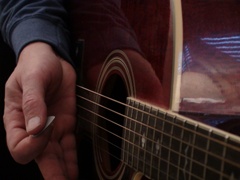Transporting Your Guitar
-

In the early days you may not have occasion to take the guitar out of the house too often. Opting to stay holed up in "practice mode" before unleashing your guitar prowess on the world.
But there will come a time when you will want to venture out the door with your guitar and, when that time comes, you will want to be prepared to help your guitar face the elements.

Most guitars are composed of various woods and metals, materials that can be sensitive to changes in climate. A difference in humidity or temperature, even a slight one, can have an impact on your guitar.
Guitar necks have a tendency to twist in reaction to heat or cold, strings go sharp upon entering an air conditioned room, and on a high humidity day playing outdoors, you can feel the fretboard soaking up the moisture.
What can you do to protect your investment?
First of all, of course, you want to make sure you have a sturdy hard shell guitar case or a heavily padded gig bag that fits your guitar securely. This may sound like stating the obvious but back when I owned a music store it would never cease to amaze me the number of people I would see hauling a “naked” guitar around in their back seat or trunk. This is just asking for trouble, so even if a case or gig bag is not in the budget right now, at least try to wrap it in a heavy blanket or, if you have saved it, the box the guitar came in when you purchased it.
Guitar cases come in all shapes and sizes and the merits of the different varieties are the subject of another discussion, but if your guitar is traveling with you on a regular basis a good hard shell case is your best bet. The operative word here is “good”.
 I once flew into Chicago with my late ‘60’s Les Paul which I transported in the original beat up case. The case had a lot of wear and tear and a couple of the latches were not working properly so I used to take an old belt and strap it around the case as a safety measure. When I got into O’Hare and got on the long escalator down to the baggage claim area, I never will forget the shock of looking down at the turnstile as my guitar came around the conveyor belt. Even from that distance I could see that the belt had slipped off and the case lid had popped open. Visions of broken necks, snapped tuning pegs and cracked head stocks immediately raced through my mind. The escalator was packed and there was no way to get down there any faster so by the time I finally did reach the bottom I had also reached a state of panic.
I once flew into Chicago with my late ‘60’s Les Paul which I transported in the original beat up case. The case had a lot of wear and tear and a couple of the latches were not working properly so I used to take an old belt and strap it around the case as a safety measure. When I got into O’Hare and got on the long escalator down to the baggage claim area, I never will forget the shock of looking down at the turnstile as my guitar came around the conveyor belt. Even from that distance I could see that the belt had slipped off and the case lid had popped open. Visions of broken necks, snapped tuning pegs and cracked head stocks immediately raced through my mind. The escalator was packed and there was no way to get down there any faster so by the time I finally did reach the bottom I had also reached a state of panic.
Fortunately the story had a happy ending and nothing was broken but it could have just as easily ended in disaster. I have never forgotten that incident and what an idiot I felt like afterwards for being so careless.
Ever since then I never flew again without first putting my guitar in a solid hard shell case, and then putting that case in an anvil flight case. When I flew to London a couple of years ago for some gigs in Wales I took my beloved PRS Triple Soap Bar securely locked in a case and then in a flight case so, when I reached the baggage claim in Gatwick, it was good as new and when I took the guitar out it was still in tune! Never trust the luggage jockeys to abide by the “Fragile” sticker they put on when checking your guitar in. You should, in fact, fully expect them to take it as an invitation to take your axe on a little “cargo surfing”.
 When considering your best options for transporting a guitar it is best to assess what your particular situation is. If you are just going back and forth to guitar lessons at your local music store and you don’t leave the guitar in the car for long periods in extreme weather then you should be fine. Likewise if you are simply going over to a buddy’s house to jam a little.
When considering your best options for transporting a guitar it is best to assess what your particular situation is. If you are just going back and forth to guitar lessons at your local music store and you don’t leave the guitar in the car for long periods in extreme weather then you should be fine. Likewise if you are simply going over to a buddy’s house to jam a little.
If you are playing with a local band and gigging a lot you will need to exercise more caution, especially if the guitars are getting thrown into a trailer with the rest of the equipment. I personally will never let my guitar ride in the trailer, even if I have to make the drummer ride back there to free up room in the van for my guitar! (just kidding, bad drummer joke!)
Then again, if you are a road musician you probably already have your guitar snuggled down pretty tightly between gigs but I have found that a flight case works just as well for putting a guitar in the cargo hold of a tour bus as it does an airplane. It just helps for a little peace of mind when all the equipment is shifting while banging over potholes.
 Regardless of where you will be transporting a guitar there is one good habit you can get into. When taking the guitar from a hot summer day into a cold air conditioned building – or visa versa – always try to let the guitar sit with the case lid cracked open (or zipper unzipped) for a few minutes before taking it out of the case. This gives the guitar a chance to slowly get acclimated to the new climate. It is always good to be mindful of the effect that going from one extreme temperature or climate to another is going to have on your guitar. In addition, never ever leave your guitar in the trunk. It can do terrible things to your neck and can ruin or crack the finish on your guitar.
Regardless of where you will be transporting a guitar there is one good habit you can get into. When taking the guitar from a hot summer day into a cold air conditioned building – or visa versa – always try to let the guitar sit with the case lid cracked open (or zipper unzipped) for a few minutes before taking it out of the case. This gives the guitar a chance to slowly get acclimated to the new climate. It is always good to be mindful of the effect that going from one extreme temperature or climate to another is going to have on your guitar. In addition, never ever leave your guitar in the trunk. It can do terrible things to your neck and can ruin or crack the finish on your guitar.
At the end of the day transporting a guitar is nowhere close to rocket science. But it is important to always remain aware of what kind of environment you are taking your guitar from, and to; as well as where it will be riding during the trip. A well built guitar is a pretty resilient creature and with a little extra effort, and the right case or gig bag, you can rest assured that the investment you made in that treasured axe will pay you back with dividends for years to come.
Please do not hesitate to contact us with any questions!


 I would say your course is the best on the internet and your communication is unbelievable! Your simplified diagrams and patient video demonstrations are like a refreshing breath of cool air. If I can help convince any fence sitters don't hesitate to refer them to me.
I would say your course is the best on the internet and your communication is unbelievable! Your simplified diagrams and patient video demonstrations are like a refreshing breath of cool air. If I can help convince any fence sitters don't hesitate to refer them to me. From: Keith Dean
From: Keith Dean The fact is, that playing guitar should be fun. It should be a source of relaxation and enjoyment. It can also be a little stressful in the beginning - learning all that new terminology, training your fingers to do things they've never done before, learning the names of notes, the blisters on your fingers and not knowing if you are playing it correctly!
The fact is, that playing guitar should be fun. It should be a source of relaxation and enjoyment. It can also be a little stressful in the beginning - learning all that new terminology, training your fingers to do things they've never done before, learning the names of notes, the blisters on your fingers and not knowing if you are playing it correctly! Lesson programs can be tailored to the individual student and the instructor can guide the student in a hands on fashion.
Lesson programs can be tailored to the individual student and the instructor can guide the student in a hands on fashion. The downside is that some of the quality courses can be on the pricey side, and also, it can be cumbersome keeping up with books and DVDs. If the coffee gets spilled on the lesson book or the dog chews up the DVD, the student has to re-order.
The downside is that some of the quality courses can be on the pricey side, and also, it can be cumbersome keeping up with books and DVDs. If the coffee gets spilled on the lesson book or the dog chews up the DVD, the student has to re-order. Many students prefer a combination of the above choices, choosing to start with an online course and then graduate to private lessons later on. As a guitar instructor, I can say that I always prefer to take on a new student that already has the basics under their belt. It is always more satisfying to help a student develop their style on guitar as opposed to spending weeks teaching them how to play an "E" chord.
Many students prefer a combination of the above choices, choosing to start with an online course and then graduate to private lessons later on. As a guitar instructor, I can say that I always prefer to take on a new student that already has the basics under their belt. It is always more satisfying to help a student develop their style on guitar as opposed to spending weeks teaching them how to play an "E" chord.
 I once flew into Chicago with my late ‘60’s Les Paul which I transported in the original beat up case. The case had a lot of wear and tear and a couple of the latches were not working properly so I used to take an old belt and strap it around the case as a safety measure. When I got into O’Hare and got on the long escalator down to the baggage claim area, I never will forget the shock of looking down at the turnstile as my guitar came around the conveyor belt. Even from that distance I could see that the belt had slipped off and the case lid had popped open. Visions of broken necks, snapped tuning pegs and cracked head stocks immediately raced through my mind. The escalator was packed and there was no way to get down there any faster so by the time I finally did reach the bottom I had also reached a state of panic.
I once flew into Chicago with my late ‘60’s Les Paul which I transported in the original beat up case. The case had a lot of wear and tear and a couple of the latches were not working properly so I used to take an old belt and strap it around the case as a safety measure. When I got into O’Hare and got on the long escalator down to the baggage claim area, I never will forget the shock of looking down at the turnstile as my guitar came around the conveyor belt. Even from that distance I could see that the belt had slipped off and the case lid had popped open. Visions of broken necks, snapped tuning pegs and cracked head stocks immediately raced through my mind. The escalator was packed and there was no way to get down there any faster so by the time I finally did reach the bottom I had also reached a state of panic. When considering your best options for transporting a guitar it is best to assess what your particular situation is. If you are just going back and forth to guitar lessons at your local music store and you don’t leave the guitar in the car for long periods in extreme weather then you should be fine. Likewise if you are simply going over to a buddy’s house to jam a little.
When considering your best options for transporting a guitar it is best to assess what your particular situation is. If you are just going back and forth to guitar lessons at your local music store and you don’t leave the guitar in the car for long periods in extreme weather then you should be fine. Likewise if you are simply going over to a buddy’s house to jam a little. Regardless of where you will be transporting a guitar there is one good habit you can get into. When taking the guitar from a hot summer day into a cold air conditioned building – or visa versa – always try to let the guitar sit with the case lid cracked open (or zipper unzipped) for a few minutes before taking it out of the case. This gives the guitar a chance to slowly get acclimated to the new climate. It is always good to be mindful of the effect that going from one extreme temperature or climate to another is going to have on your guitar. In addition, never ever leave your guitar in the trunk. It can do terrible things to your neck and can ruin or crack the finish on your guitar.
Regardless of where you will be transporting a guitar there is one good habit you can get into. When taking the guitar from a hot summer day into a cold air conditioned building – or visa versa – always try to let the guitar sit with the case lid cracked open (or zipper unzipped) for a few minutes before taking it out of the case. This gives the guitar a chance to slowly get acclimated to the new climate. It is always good to be mindful of the effect that going from one extreme temperature or climate to another is going to have on your guitar. In addition, never ever leave your guitar in the trunk. It can do terrible things to your neck and can ruin or crack the finish on your guitar.